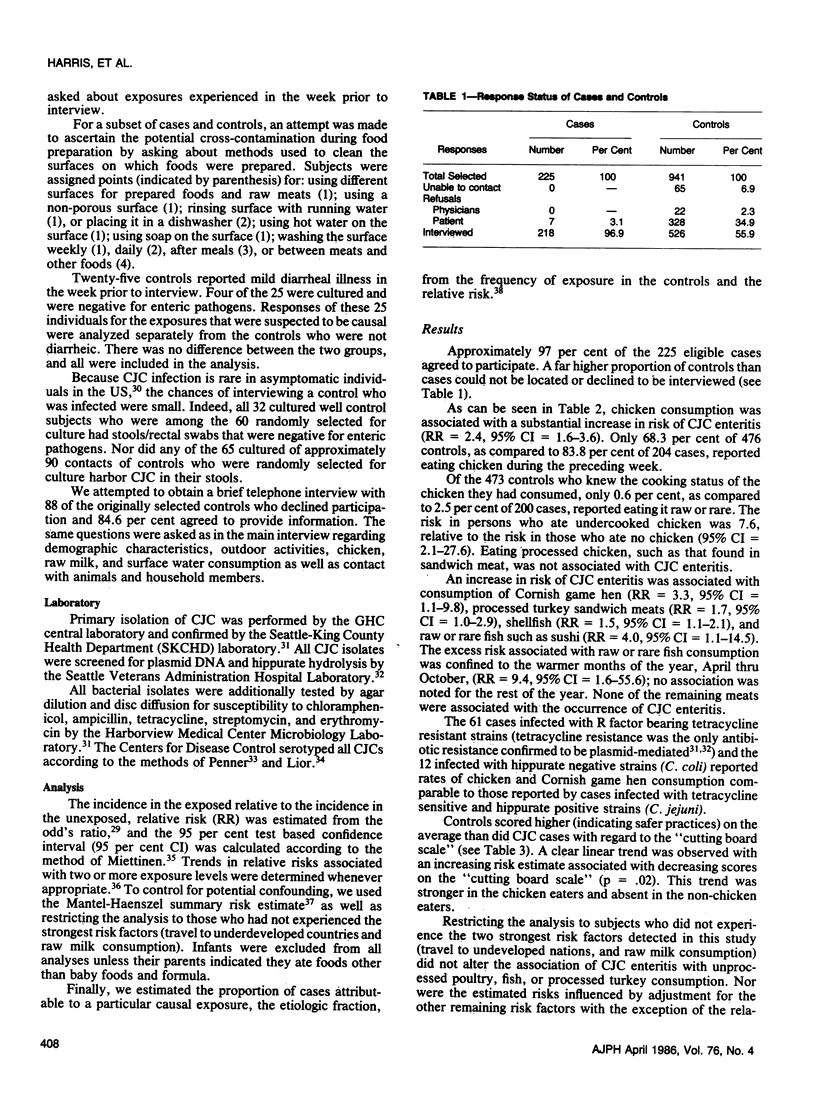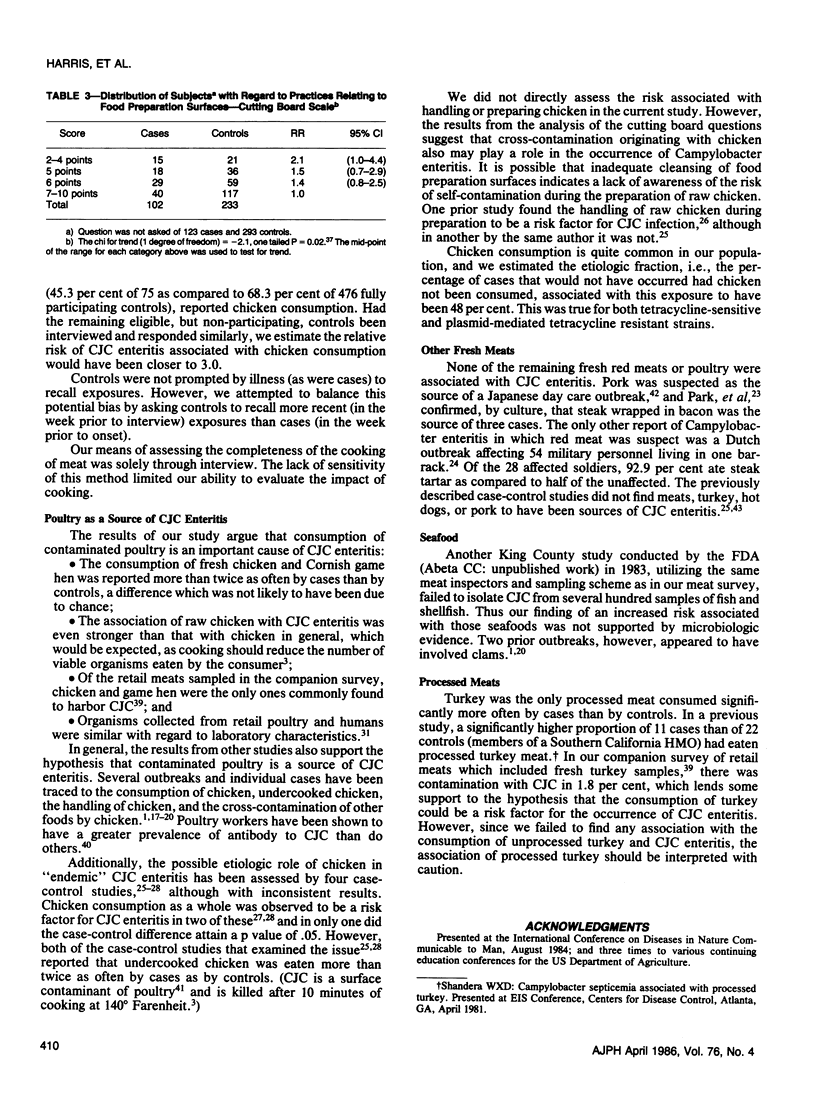Abstract
To determine the role of meats as possible sources of infection leading to Campylobacter jejuni/coli (CJC) enteritis, 218 cases and 526 controls were selected from the King County Group Health Cooperative (GHC) population from April 1982 through September 1983. All subjects were interviewed regarding food consumption one week prior to case onset. Consumption of chicken and cornish game hen were both associated with more than a doubling of the risk of CJC enteritis: for chicken (relative risk = 2.4, 95% CI = 1.6-3.6), and for game hen, (RR = 3.3, 95% CI = 1.1-9.8). The consumption of raw or rare chicken was even more strongly associated (RR = 7.6, 95% CI = 2.1-27.6). Strains of CJC bearing R factors for tetracycline were equally as likely as tetracycline-susceptible strains to have been acquired from chicken and game hens. Processed turkey sandwich meats (RR = 1.7, 95% CI = 1.0-2.9) raw or rare fish (RR = 4.0, 95% CI = 1.1-14.5) and shellfish (RR = 1.5, 95% CI = 1.1-2.1) were the only other meats reported to have been eaten significantly (p less than .05) more often by cases than by controls. These data along with the results of bacteriologic sampling of meats from King County retail food markets during the same period suggest that ingestion of contaminated chicken is a primary source of CJC enteritis, contributing to approximately half of the cases.
Full text
PDF




Selected References
These references are in PubMed. This may not be the complete list of references from this article.
- Barot M. S., Mosenthal A. C., Bokkenheuser V. D. Location of Campylobacter jejuni in infected chicken livers. J Clin Microbiol. 1983 May;17(5):921–922. doi: 10.1128/jcm.17.5.921-922.1983. [DOI] [PMC free article] [PubMed] [Google Scholar]
- Blaser M. J., Berkowitz I. D., LaForce F. M., Cravens J., Reller L. B., Wang W. L. Campylobacter enteritis: clinical and epidemiologic features. Ann Intern Med. 1979 Aug;91(2):179–185. doi: 10.7326/0003-4819-91-2-179. [DOI] [PubMed] [Google Scholar]
- Brouwer R., Mertens M. J., Siem T. H., Katchaki J. An explosive outbreak of Campylobacter enteritis in soldiers. Antonie Van Leeuwenhoek. 1979;45(3):517–519. doi: 10.1007/BF00443293. [DOI] [PubMed] [Google Scholar]
- Christenson B., Ringner A., Blücher C., Billaudelle H., Gundtoft K. N., Eriksson G., Böttiger M. An outbreak of campylobacter enteritis among the staff of a poultry abattoir in Sweden. Scand J Infect Dis. 1983;15(2):167–172. doi: 10.3109/inf.1983.15.issue-2.07. [DOI] [PubMed] [Google Scholar]
- Firehammer B. D., Myers L. L. Campylobacter fetus subsp jejuni: its possible significance in enteric disease of calves and lambs. Am J Vet Res. 1981 Jun;42(6):918–922. [PubMed] [Google Scholar]
- Gill C. O., Harris L. M. Contamination of red-meat carcasses by Campylobacter fetus subsp. jejuni. Appl Environ Microbiol. 1982 May;43(5):977–980. doi: 10.1128/aem.43.5.977-980.1982. [DOI] [PMC free article] [PubMed] [Google Scholar]
- Harris N. V., Thompson D., Martin D. C., Nolan C. M. A survey of Campylobacter and other bacterial contaminants of pre-market chicken and retail poultry and meats, King County, Washington. Am J Public Health. 1986 Apr;76(4):401–406. doi: 10.2105/ajph.76.4.401. [DOI] [PMC free article] [PubMed] [Google Scholar]
- Hopkins R. S., Olmsted R., Istre G. R. Endemic Campylobacter jejuni infection in Colorado: identified risk factors. Am J Public Health. 1984 Mar;74(3):249–250. doi: 10.2105/ajph.74.3.249. [DOI] [PMC free article] [PubMed] [Google Scholar]
- Hopkins R. S., Scott A. S. Handling raw chicken as a source for sporadic Campylobacter jejuni infections. J Infect Dis. 1983 Oct;148(4):770–770. doi: 10.1093/infdis/148.4.770. [DOI] [PubMed] [Google Scholar]
- Hänninen M. L., Raevuori M. Occurrence of Campylobacter fetus subsp. jejuni and Yersinia enterocolitica in domestic animals and in some foods of animal origin in Finland. Nord Vet Med. 1981 Sep-Nov;33(9-11):441–445. [PubMed] [Google Scholar]
- Itoh T., Saito K., Maruyama T., Sakai S., Ohashi M., Oka A. An outbreak of acute enteritis due to Campylobacter fetus subspecies jejuni at a nursery school of Tokyo. Microbiol Immunol. 1980;24(5):371–379. doi: 10.1111/j.1348-0421.1980.tb02841.x. [DOI] [PubMed] [Google Scholar]
- Jørgensen K. Forekomst af Campylobacter hos svin. Nord Vet Med. 1979 Dec;31(12):534–534. [PubMed] [Google Scholar]
- Kinde H., Genigeorgis C. A., Pappaioanou M. Prevalence of Campylobacter jejuni in chicken wings. Appl Environ Microbiol. 1983 Mar;45(3):1116–1118. doi: 10.1128/aem.45.3.1116-1118.1983. [DOI] [PMC free article] [PubMed] [Google Scholar]
- Lior H., Woodward D. L., Edgar J. A., Laroche L. J., Gill P. Serotyping of Campylobacter jejuni by slide agglutination based on heat-labile antigenic factors. J Clin Microbiol. 1982 May;15(5):761–768. doi: 10.1128/jcm.15.5.761-768.1982. [DOI] [PMC free article] [PubMed] [Google Scholar]
- MANTEL N., HAENSZEL W. Statistical aspects of the analysis of data from retrospective studies of disease. J Natl Cancer Inst. 1959 Apr;22(4):719–748. [PubMed] [Google Scholar]
- Miettinen O. Estimability and estimation in case-referent studies. Am J Epidemiol. 1976 Feb;103(2):226–235. doi: 10.1093/oxfordjournals.aje.a112220. [DOI] [PubMed] [Google Scholar]
- Oosterom J., Beckers H. J., van Noorle Jansen L. M., van Schothorst M. Een explosie van Campylobacter-infectie in een kazerne, waarschijnlijk veroorzaakt door rauwe tartaar. Ned Tijdschr Geneeskd. 1980 Sep 27;124(39):1631–1634. [PubMed] [Google Scholar]
- Penner J. L., Hennessy J. N. Passive hemagglutination technique for serotyping Campylobacter fetus subsp. jejuni on the basis of soluble heat-stable antigens. J Clin Microbiol. 1980 Dec;12(6):732–737. doi: 10.1128/jcm.12.6.732-737.1980. [DOI] [PMC free article] [PubMed] [Google Scholar]
- Rosef O. Isolation of Campylobacter fetus subsp. jejuni from the gallbladder of normal slaughter pigs, using an enrichment procedure. Acta Vet Scand. 1981;22(1):149–151. doi: 10.1186/BF03547219. [DOI] [PMC free article] [PubMed] [Google Scholar]
- Rosef O., Kapperud G. Isolation of Campylobacter fetus subsp. jejuni from faeces of Norwegian poultry. Acta Vet Scand. 1982;23(1):128–134. doi: 10.1186/BF03546829. [DOI] [PMC free article] [PubMed] [Google Scholar]
- Shanker S., Rosenfield J. A., Davey G. R., Sorrell T. C. Campylobacter jejuni: incidence in processed broilers and biotype distribution in human and broiler isolates. Appl Environ Microbiol. 1982 May;43(5):1219–1220. doi: 10.1128/aem.43.5.1219-1220.1982. [DOI] [PMC free article] [PubMed] [Google Scholar]
- Smeltzer T. I. Isolation of Campylobacter jejuni from poultry carcases. Aust Vet J. 1981 Nov;57(11):511–512. doi: 10.1111/j.1751-0813.1981.tb05785.x. [DOI] [PubMed] [Google Scholar]
- Tenover F. C., Williams S., Gordon K. P., Nolan C., Plorde J. J. Survey of plasmids and resistance factors in Campylobacter jejuni and Campylobacter coli. Antimicrob Agents Chemother. 1985 Jan;27(1):37–41. doi: 10.1128/aac.27.1.37. [DOI] [PMC free article] [PubMed] [Google Scholar]
- Wempe J. M., Genigeorgis C. A., Farver T. B., Yusufu H. I. Prevalence of Campylobacter jejuni in two California chicken processing plants. Appl Environ Microbiol. 1983 Feb;45(2):355–359. doi: 10.1128/aem.45.2.355-359.1983. [DOI] [PMC free article] [PubMed] [Google Scholar]
- Yamamura K., Sato I., Fujimoto N. [Isolation of Campylobacter jejuni from chicken feces and their survival period in minced chicken]. Kansenshogaku Zasshi. 1983 Sep;57(9):817–822. doi: 10.11150/kansenshogakuzasshi1970.57.817. [DOI] [PubMed] [Google Scholar]


